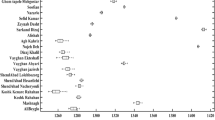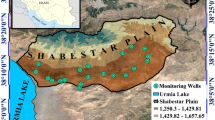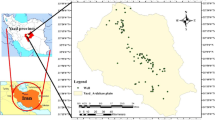Abstract
Predicting the groundwater level (GWL) is essential in water resource management and irrigation planning in arid and semi-arid areas. In this study, an artificial neural network (ANN) was combined with newly developed wild horse optimizer (WHO) and egret swarm optimization algorithm (ESOA) techniques to predict a one month lead-time GWL in the Tabriz plain of Iran. For the prediction of the GWL, the number of months and years, the one month lag of average temperature, evaporation, precipitation, and GWL were used as inputs. Model performances were compared using root mean square error (RMSE), Nash–Sutcliffe efficiency (NSE), coefficient of determination (R2), and relative strength ratio (RSR) statistical indicators and scatter diagrams, time series graph, violin graph, and Taylor diagram. As a result of the analysis, the most successful estimation results were obtained with the input combinations of year, month, average temperature, evaporation, precipitation, and GWL (t − 1) for the prediction of the one month lead-time GWL. According to the results of evaluation indicators in the testing phase, ANN with (R2 = 0.871, RMSE = 0.306 (m), NSE = 0.832, and RSR = 0.410), WHO–ANN (R2 = 0.932, RMSE = 0.200 (m), NSE = 0.929, and RSR = 0.267), and ESOA–ANN (R2 = 0.952, RMSE = 0.164 (m), NSE = 0.951, and RSR = 0.220). In addition, it was revealed that the ESOA–ANN hybrid model showed higher prediction success than the WHO–ANN and standalone ANN models. The study outputs contribute to decision-makers and planners for controlling land subsidence, assessing GWL and aquifer compaction, irrigation planning, and effective management of water resources.











Similar content being viewed by others
Availability of data and materials
All data generated or analyzed during this study are included in this published article.
Abbreviations
- ANFIS:
-
Adaptive neuro-fuzzy inference system
- ANN:
-
Artificial neural network
- CEEMD:
-
Complementary ensemble empirical mode decomposition
- EEMD:
-
Ensemble empirical mode decomposition
- ESOA:
-
Egret swarm optimization algorithm
- GEP:
-
Gene expression programming
- GWL:
-
Groundwater level
- GWO:
-
Gray wolf optimization
- KNN-RF:
-
K-Nearest neighbor-random forest
- LSTM:
-
Long short-term memory
- MIC:
-
Maximum information coefficient
- NSE:
-
Nash–Sutcliffe efficiency
- PSO:
-
Particle swarm optimization
- QPSO:
-
Quantum-particle swarm optimization
- R 2 :
-
Coefficient of determination
- RMSE:
-
Root mean square error
- RSR:
-
Relative strength ratio
- SAELM:
-
Self-adaptive extreme learning machine
- SVM:
-
Support vector machine
- SVR:
-
Support vector regression
- WHO:
-
Wild horse optimizer
References
Abiye T, Masindi K, Mengistu H, Demlie M (2018) Understanding the groundwater-level fluctuations for better management of groundwater resource: a case in the Johannesburg region. Groundw Sustain Dev 7:1–7
Adnan RM, Dai HL, Mostafa RR, Islam ARMT, Kisi O, Heddam S, Zounemat-Kermani M (2023) Modelling groundwater level fluctuations by ELM merged advanced metaheuristic algorithms using hydroclimatic data. Geocarto Int 38(1):2158951
Ahmadi A, Olyaei M, Heydari Z, Emami M, Zeynolabedin A, Ghomlaghi A, Daccache A, Fogg GE, Sadegh M (2022) Groundwater level modeling with machine learning: a systematic review and meta-analysis. Water 14(6):949
Bahmani R, Ouarda TB (2021) Groundwater level modeling with hybrid artificial intelligence techniques. J Hydrol 595:125659
Balavalikar S, Nayak P, Shenoy N, Nayak K (2018) Particle swarm optimization based artificial neural network model for forecasting groundwater level in Udupi district. In: AIP conference proceedings, vol 1952, no. 1. AIP Publishing LLC, p 020021
Band SS, Heggy E, Bateni SM, Karami H, Rabiee M, Samadianfard S, Chau KW, Mosavi A (2021) Groundwater level prediction in arid areas using wavelet analysis and Gaussian process regression. Eng Appl Comput Fluid Mech 15(1):1147–1158
Barzegar R, Asghari Moghaddam A, Kazemian N (2015) Assessment of heavy metals concentrations with emphasis on arsenic in the Tabriz plain aquifers. Iran Environ Earth Sci 74(1):297–313
Barzegar R, Asghari Moghaddam A, Tziritis E (2017) Hydrogeochemical features of groundwater resources in Tabriz plain, northwest of Iran. Appl Water Sci 7:3997–4011
Barzegar R, Fijani E, Moghaddam AA, Tziritis E (2017) Forecasting of groundwater level fluctuations using ensemble hybrid multi-wavelet neural network-based models. Sci Total Environ 599:20–31
Bhadani V, Singh A, Kumar V, Gaurav K (2023) Machine learning models to predict groundwater level in a Semi-arid river catchment, Central India (No. EGU23–12629). Copernicus Meetings
Brzorad JN, Maccarone AD, Conley KJ (2004) Foraging energetics of great egrets and snowy egrets. J Field Ornithol 75(3):266–280
Chai T, Draxler RR (2014) Root mean square error (RMSE) or mean absolute error (MAE)? Arguments against avoiding RMSE in the literature. Geosci Model Dev 7(3):1247–1250
Chen Z, Francis A, Li S, Liao B, Xiao D, Ha T, Li J, Ding L, Cao X (2022) Egret swarm optimization algorithm: An evolutionary computation approach for model free optimization. Biomimetics 7(4):144
Chidepudi SKR, Massei N, Jardani A, Henriot A, Allier D, Baulon L (2023) A wavelet-assisted deep learning approach for simulating groundwater levels affected by low-frequency variability. Sci Total Environ 865:161035
Dimalexis A, Pyrovetsi M, Sgardelis S (1997) Foraging ecology of the grey heron (Ardea cinerea), great egret (Ardea alba) and little egret (Egretta garzetta) in response to habitat, at 2 Greek wetlands. Colon Waterbirds 20(2):261–272
Fathy A, Rezk H, Yousri D, Alhelou HH (2023) Recent approach of wild horse optimizer for identifying the optimal parameters of high efficiency triple-junction solar system. IET Renew Power Gener 17(4):856–872
Goel A, Goel AK, Kumar A (2023) The role of artificial neural network and machine learning in utilizing spatial information. Spat Inf Res 31(3):275–285
Hosseini Z, Gharechelou S, Nakhaei M, Gharechelou S (2016) Optimal design of BP algorithm by ACOR model for groundwater-level forecasting: a case study on Shabestar plain, Iran. Arab J Geosci 9(6):1–16
Ibrahim KSMH, Huang YF, Ahmed AN, Koo CH, El-Shafie A (2022) A review of the hybrid artificial intelligence and optimization modelling of hydrological streamflow forecasting. Alex Eng J 61(1):279–303
Jafari R, Torabian A, Ghorbani MA, Mirbagheri SA, Hassani AH (2019) Prediction of groundwater quality parameter in the Tabriz plain, Iran using soft computing methods. J Water Supply Res Technol AQUA 68(7):573–584
Jeihouni M, Delirhasannia R, Alavipanah SK, Shahabi M, Samadianfard S (2015) Spatial analysis of groundwater electrical conductivity using ordinary kriging and artificial intelligence methods (Case Study: Tabriz Plain, Iran). G eofizika 32(2):191–208
Kayhomayoon Z, Babaeian F, Ghordoyee Milan S, Arya Azar N, Berndtsson R (2022) A combination of metaheuristic optimization algorithms and machine learning methods improves the prediction of groundwater level. Water 14(5):751
Kent DM (1986) Behavior, habitat use, and food of three egrets in a marine habitat. Colon Waterbirds 9(1):25-30
Khan J, Lee E, Balobaid AS, Kim K (2023) A comprehensive review of conventional, machine leaning, and deep learning models for groundwater level (GWL) forecasting. Appl Sci 13(4):2743
Kingma DP, Ba J (2015) A method for stochastic optimization. In: Proceedings of the international conference on learning representations (ICLR), San Diego, CA, USA
Kombo OH, Kumaran S, Sheikh YH, Bovim A, Jayavel K (2020) Long-term groundwater level prediction model based on hybrid KNN-RF technique. Hydrology 7(3):59
Legates DR, McCabe GJ Jr (1999) Evaluating the use of “goodness-of-fit” measures in hydrologic and hydroclimatic model validation. Water Resour Res 35(1):233–241
Li T, Liu Y, Chen Z (2022) Application of sine cosine egret swarm optimization algorithm in gas turbine cooling system. Systems 10(6):201
Loucks DP, van Beek E (2017) Water resources planning and management: an overview. In: Water resource systems planning and management. Springer International Publishing, pp 1–49. https://doi.org/10.1007/978-3-319-44234-1_1
Maccarone AD, Brzorad JN (2007) Foraging behavior and energetics of Great Egrets and Snowy Egrets at interior rivers and weirs. J Field Ornithol 78(4):411–419
Maccarone AD, Brzorad JN, Stone HM (2008) Characteristics and energetics of Great Egret and Snowy Egret foraging flights. Waterbirds 31(4):541–549
Maccarone AD, Brzorad JN, Stone HM (2012) A telemetry-based study of Snowy Egret (Egretta thula) nest-activity patterns, food-provisioning rates and foraging energetics. Waterbirds 35(3):394–401
Malekzadeh M, Kardar S, Saeb K, Shabanlou S, Taghavi L (2019) A novel approach for prediction of monthly ground water level using a hybrid wavelet and non-tuned self-adaptive machine learning model. Water Resour Manag 33(4):1609–1628
Master TL, Leiser JK, Bennett KA, Bretsch JK, Wolfe HJ (2005) Patch selection by snowy egrets. Waterbirds 28(2):220–224
Mirzania E, Vishwakarma DK, Bui QAT, Band SS, Dehghani R (2023) A novel hybrid AIG-SVR model for estimating daily reference evapotranspiration. Arab J Geosci 16(5):1–14
Moghaddam HK, Moghaddam HK, Kivi ZR, Bahreinimotlagh M, Alizadeh MJ (2019) Developing comparative mathematic models, BN and ANN for forecasting of groundwater levels. Groundw Sustain Dev 9:100237
Mohammed KS, Shabanlou S, Rajabi A, Yosefvand F, Izadbakhsh MA (2023) Prediction of groundwater level fluctuations using artificial intelligence-based models and GMS. Appl Water Sci 13(2):54
Motwakel A, Alabdulkreem E, Gaddah A, Marzouk R, Salem NM, Zamani AS, Abdelmageed AA, Eldesouki MI (2023) Wild horse optimization with deep learning-driven short-term load forecasting scheme for smart grids. Sustainability 15(2):1524
Naruei I, Keynia F (2022) Wild horse optimizer: a new meta-heuristic algorithm for solving engineering optimization problems. Eng Comput 38(4):3025–3056
Natarajan N, Sudheer C (2020) Groundwater level forecasting using soft computing techniques. Neural Comput Appl 32(12):7691–7708
Pham QB, Kumar M, Di Nunno F, Elbeltagi A, Granata F, Islam ARMT, Talukdar S, Nguyen XC, Ahmed AN, Anh DT (2022) Groundwater level prediction using machine learning algorithms in a drought-prone area. Neural Comput Appl 34(13):10751–10773
Puig-Arnavat M, Bruno JC (2015) Artificial neural networks for thermochemical conversion of biomass. In: Recent advances in thermo-chemical conversion of biomass. Elsevier, pp 133–156. https://doi.org/10.1016/B978-0-444-63289-0.00005-3
Roshni T, Mirzania E, Hasanpour Kashani M, Bui QAT, Shamshirband S (2022) Hybrid support vector regression models with algorithm of innovative gunner for the simulation of groundwater level. Acta Geophys 70(4):1885–1898
Roy DK, Biswas SK, Mattar MA, El-Shafei AA, Murad KFI, Saha KK, Datta B, Dewidar AZ (2021) Groundwater level prediction using a multiple objective genetic algorithm-grey relational analysis based weighted ensemble of ANFIS models. Water 13(21):3130
Samani S, Vadiati M, Azizi F, Zamani E, Kisi O (2022) Groundwater level simulation using soft computing methods with emphasis on major meteorological components. Water Resour Manag 36(10):3627–3647
Saravanan G, Neelakandan S, Ezhumalai P, Maurya S (2023) Improved wild horse optimization with levy flight algorithm for effective task scheduling in cloud computing. J Cloud Comput 12(1):24
Saroughi M, Mirzania E, Vishwakarma DK, Nivesh S, Panda KC, Daneshvar FA (2023) A novel hybrid algorithms for groundwater level prediction. Iran J Sci Technol Trans Civ Eng 47:3147–3164
Shahbazi M, Zarei H, Solgi A (2023) De-noising groundwater level modeling using data decomposition techniques in combination with artificial intelligence (case study Aspas aquifer). Appl Water Sci 13(4):88
Siade A, Rathi B, Prommer H, Welter D, Doherty J (2019) Using heuristic multi-objective optimization for quantifying predictive uncertainty associated with groundwater flow and reactive transport models. J Hydrol 577:123999
Singh AK, Kumar P, Ali R, Al-Ansari N, Vishwakarma DK, Kushwaha KS, Panda KC, Sagar A, Mirzania E, Elbeltagi A, Kuriqi A, Heddam S (2022) An integrated statistical-machine learning approach for runoff prediction. Sustainability 14(13):8209
Spea SR (2023) Social network search algorithm for combined heat and power economic dispatch. Electr Power Syst Res 221:109400
Sudheer C, Shrivastava NA, Panigrahi BK, Mathur S (2011) Groundwater level forecasting using SVM–QPSO. In: International conference on swarm, evolutionary, and memetic computing. Springer, Berlin, pp 731–741
Tao H, Hameed MM, Marhoon HA, Zounemat-Kermani M, Heddam S, Kim S, Sulaiman SO, Tan ML, Sa’adi Z, Mehr AD, Allawi MF, Abba SI, Zain JM, Falah MW, Jamei M, Bokde ND, Bayatvarkeshi M, Al-Mukhtar M, Bhagat SK, Tiyasha T, Khedher KM, Al-Ansari N, Shahid S, Yaseen ZM (2022) Groundwater level prediction using machine learning models: a comprehensive review. Neurocomputing 489:271–308
Velis M, Conti KI, Biermann F (2017) Groundwater and human development: synergies and trade-offs within the context of the sustainable development goals. Sustain Sci 12(6):1007–1017
Wiggins DA (1991) Foraging success and aggression in solitary and group-feeding Great Egrets (Casmerodius albus). Colon Waterbirds 14(2):176–179
Yang L, Shami A (2020) On hyperparameter optimization of machine learning algorithms: theory and practice. Neurocomputing 415:295–316
Yin W, Fan Z, Tangdamrongsub N, Hu L, Zhang M (2021) Comparison of physical and data-driven models to forecast groundwater level changes with the inclusion of GRACE—a case study over the state of Victoria. Aust J Hydrol 602:126735
Zare M, Koch M (2021) Hybrid signal processing/machine learning and PSO optimization model for conjunctive management of surface–groundwater resources. Neural Comput Appl 33(13):8067–8088
Zeng T, Yin K, Jiang H, Liu X, Guo Z, Peduto D (2022) Groundwater level prediction based on a combined intelligence method for the Sifangbei landslide in the Three Gorges Reservoir Area. Sci Rep 12(1):1–19
Zhou J, Wang D, Band SS, Mirzania E, Roshni T (2023) Atmosphere air temperature forecasting using the honey badger optimization algorithm: on the warmest and coldest areas of the world. Eng Appl Comput Fluid Mech 17(1):2174189
Funding
The authors declare that no funds or grants were received during the preparation of this manuscript.
Author information
Authors and Affiliations
Contributions
All authors contributed to the study’s conception and design. All authors read and approved the final manuscript.
Corresponding author
Ethics declarations
Conflict of interests
The authors declare that they have no known competing financial interests or personal relationships that could have appeared to influence the work reported in this paper.
Ethical approval
The authors confirm that this article is original research and has not been published previously in any journal in any language.
Consent to participate
Not applicable.
Consent to publish
Not applicable.
Additional information
Publisher’s Note
Springer Nature remains neutral with regard to jurisdictional claims in published maps and institutional affiliations.
Rights and permissions
Springer Nature or its licensor (e.g. a society or other partner) holds exclusive rights to this article under a publishing agreement with the author(s) or other rightsholder(s); author self-archiving of the accepted manuscript version of this article is solely governed by the terms of such publishing agreement and applicable law.
About this article
Cite this article
Mirzania, E., Achite, M., Elshaboury, N. et al. Prediction of monthly groundwater level using a new hybrid intelligent approach in the Tabriz plain, Iran. Neural Comput & Applic (2024). https://doi.org/10.1007/s00521-024-09681-3
Received:
Accepted:
Published:
DOI: https://doi.org/10.1007/s00521-024-09681-3




